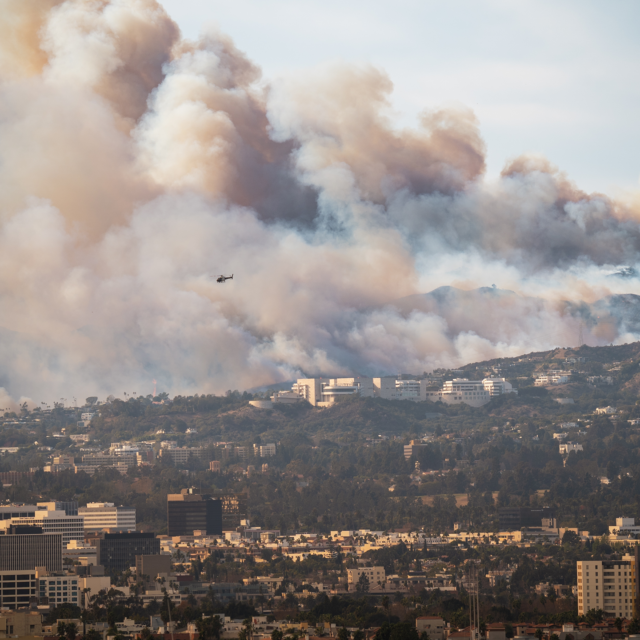Hello. I am Taylor Griffith, the Ten Across digital journalism fellow. In January, I attended the Ten Across Summit in Houston. In the “The Future is Here” blog series, I reflect on salient themes I heard in summit discussions and how I see them impact my own life and career.
In this final post of our “The Future is Here” blog series, I focus on the topic of achieving a national energy transition and the challenges that come with it. Houston, often referred to as the Energy Capital of the World, provided an ideal backdrop for the thoughtful perspectives shared by Ten Across Summit participants—insights that made it clear to me that there is no better time for an energy revolution than now.
The Challenge Ahead
Pollution created from fossil fuel extraction and usage has undeniably led to a concerning rise in global temperatures. The latest Intergovernmental Panel on Climate Change report highlights this impact and anticipates that average annual temperatures may rise 1.5 to 2 degrees Celsius over pre-Industrial levels before the end of this century.
Every fraction of a degree we can prevent is crucial for countless communities — especially in Greater Phoenix, where I was raised and still currently reside. For those unsheltered or dealing with energy insecurity, record temperatures consistently reaching 120 degrees or higher could mean life or death.
New York Times best-selling author Jeff Goodell reinforced this during the “Boiling Point: Addressing the Challenges of a Rapidly Warming World” summit discussion:
“Heat is on a different order than other climate impacts. It is the primary driver of sea-level rise, drought, wildfires, and disease change patterns. Heat is about killing things, not just humans—although a lot of humans.”
We’ve known for many decades that a transition away from fossil fuels is our greatest defense in slowing or reversing some effects of climate change. But the actual execution of this transition has been slow, and in some areas has yet to even begin.
Houston Energy Transition Initiative Chairman Bobby Tudor reminded Summit guests that incumbent oil companies are still major players in the energy space, but that this won’t be the case forever:
“My thesis is that the conventional energy business is not going away anytime soon… But it clearly is not going to be the same engine for growth that it has been historically, and the question is not whether global oil demand is going to peak, it’s simply when it’s going to peak.”
I’ll admit, before I started digging into this, I used to envision a complete closure of all U.S. oil fracking operations when I would hear the words ‘energy transition.’ But now I question whether we’ll ever see such a transformation in my lifetime. Brenda Burger, a former top executive at Chevron put it this way in her summit conversation with Time magazine senior correspondent Justin Worland:
“We’re not going to throw away the current energy system. It’s just huge. So, we’re going to evolve it. Hopefully, we’re going to repurpose a lot of things.”
We’re seeing the beginnings of this market evolution already. In 2020, solar, wind and hydropower made up 20% of utility-scale energy generation in the U.S. — a 40% increase from 2010. Meanwhile, renewable ethanol and biodiesel transportation fuels managed to claim 17% of the market in 2020, and this was a decrease from recent years due to the COVID-19 pandemic.
Who will lead the transition?
Until we see the full power of the market behind this transition, motivations to change will largely have to come from innovative energy startups, investors, government incentives and university endowments, as well as individual consumer behavior and professional prospects within the energy industry. Fortunately, city governments are significantly beginning to take the lead.
The LA100 study, led by the National Renewable Energy Laboratory (NREL) and the Los Angeles Department of Water and Power (LADWP) was initiated by former Los Angeles Mayor Eric Garcetti with the goal of achieving a 100% renewable local energy supply by 2045.
The study, supported by former Los Angeles Chief Sustainability Officer Lauren Faber O’Connor and Director of the NREL Grid Planning and Analysis Center Jaquelin Cochran, has found that those previous energy goals are now achievable as early as 2035.
O’Connor and Cochran shared their insights along with Gavin Dillingham, vice president of research at the Houston Advanced Research Center (HARC) during the “Getting to Net Zero in American Cities” Summit session.
When Los Angeles released their first sustainability plan for the city in 2015, “we knew that we were setting very aggressive goals for Los Angeles’ power system,” said O’Connor. “If we were going to transform our transportation, our buildings — it’s an increasing load and responsibility on the electricity system” to take on energy demands currently powered by fossil fuels.
In Houston, while the city recovered from the devastation of Hurricane Harvey in 2017—one of the strongest recorded hurricanes to hit the area, and exacerbated by atmospheric warming—, Mayor Sylvester Turner said he was driven to draft and implement the 2020 Houston Climate Action Plan. HARC was among the lead researchers of this resolution.
While surveying the city, Dillingham and his colleagues at HARC found that although other populous cities like Los Angeles and New York had modeled viable frameworks for transitioning to renewables, residents of this city were often seeking a ‘Houston-ized’ plan that would reflect economic and cultural priorities as an energy-dominant city.
“Fortunately, solar and wind are much more cost-competitive than they were just a few years ago, and you’re seeing a significant deployment of solar and wind and storage coming on into the Texas market, which significantly helps the City of Houston meeting some of its energy transition goals,” said Dillingham.
This marks a monumental sea change. A city that built its reputation on oil and gas is now leading the rest of the country in renewable energy usage.
Final thoughts
If we lived in a perfect world, conversations around the energy transition would not have been confined to certain industry, geographic, or political affiliations for as long as they have. But what I witnessed this January in Houston and what initially drew me to the Ten Across initiative is the continued effort to break down these silos to discover new pathways forward.
The clock is ticking on our window to prevent global warming above 1.5 degrees Celsius by 2030. The significant and scaled changes necessary to preserve a safe and desirable future for all will require unprecedented levels of transborder and interdisciplinary collaboration. We cannot get complacent, and the conversation cannot end here.
Though this is the final installment of my blog series on the Summit, I can confirm the issues covered in this four-part series will continue to appear in our research and work on the Ten Across Conversations podcast, future blog posts and events.
If you are just joining me, start this blog series from the beginning. As much as I’d hoped to, I couldn’t include an analysis of every Summit panel in this four-part series. But not to worry, you can experience the full selection of discussions here.
Summit Panel Discussions Noted in Order of Reference
Boiling Point: Addressing the Challenges of Rapidly Warming World
The Necessary Energy Transition: A Conversation with Bobby Tudor
The Necessary Energy Transition: A Perspective from the Energy Capital of the World
Getting to Net Zero in American Cities—Los Angeles and Houston as Models




